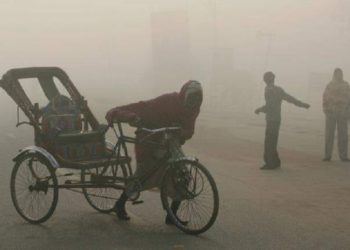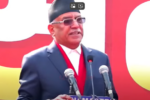The national and provincial elections have been held and have sent shock waves.
Despite massive manipulation in the nomination of candidates, continued blatant disregard for social inclusion, utopian and fairytale-like election manifestos and the subversion of democratic principles, the eternally same and long since repeatedly failed ageing party leaders have not succeeded in deceiving the electorate once again.
The top politicians were only concerned with one thing: they wanted to have their personal position of power confirmed once again by the elections so that they could continue their state-destroying power struggles for five years afterwards.
All according to the motto: Keep it up, it has always worked so far.
Protest against the political establishment
But it didn’t this time. The voters were, to put it bluntly, fed up and taught the top politicians and their parties a lesson.
The fact that this did not turn out even more clearly is due to various circumstances. For one thing, the insane electoral alliances led to the competition between the parties in the constituencies, which is typical of a democratic system, being considerably restricted. Voters could no longer decide freely.
The election results make it clear that this party has not yet reached the electorate. Although it is the third strongest party in the ruling coalition with 10 direct mandates, it fails to clear the three-percent hurdle in the PR system.
They had to be satisfied with the candidates that the party leaders had chosen for them, basta! Or else they had to resort to a protest vote.
In some constituencies, a not inconsiderable number of independent candidates have favoured the re-election of prominent top politicians.
The nationwide cadre system of the major parties also had a supportive effect on incumbent politicians.
Another plus for them is the so-called Constituency Development Fund, through which only directly elected MPs can specifically promote development projects in their constituencies and thus already work towards re-election during the ongoing legislative period.
Finally, it is also worth mentioning the effort to weaken or exclude potential competitors through accusations or even lawsuits already in the run-up to the elections.
Sometimes, the Election Commission seems to have supported such processes while turning a blind eye to the misconduct of many established politicians.
Unfortunately, even a week after the elections, not even the FPTP votes have been fully counted. Regarding the PR system, only constantly updated figures are published on the Election Commission’s website, although it is precisely here that percentage figures could already reveal a trend. If you want to get this one, you have to calculate the expected PR seats yourself.
A lesson for the established parties
It is therefore too early to draw up a comprehensive analysis, but some things can already be clearly seen.
First, there is the winner of the 2017 elections, the CPN (UML), whose chairperson had announced in his grandiloquent manner that his party would emerge from the elections with an absolute majority of seats.
In 2017, the party had won 121 of the 275 seats in an electoral alliance with the CPN (MC). This time, it will be about 40 MPs less, mainly due to losses in the FPTP system.
But even in the proportional system, the party is expected to drop by about six percent to just over 27 percent.
In this system, however, the CPN (UML) remains ahead with about the same lead over the Nepali Congress (NC) as five years ago.
So, under the PR system, the NC also loses about six per cent compared to 2017. Hence, it is only in the PR system that one can make out the status of the parties among the electorate.
The FPTP system this time was all about manipulation by the electoral alliances. Thus, the declared aim of the alliance of the five ruling parties [NC, CPN (MC), CPN (US), LSP and Janamorcha Nepal] was to ensure a continuation of the ruling coalition after the elections by means of their electoral alliance.
For this purpose, the re-election of as many leading politicians of the coalition as possible was to be made possible.
This plan has obviously failed. Thanks to candidate manipulation, at least the NC was able to gain almost as many seats in the FPTP system as the CPN (UML) lost compared to 2017.
Together with the seats from the proportional system, the party is likely to have around 90 MPs in the new House of Representatives.
For a governing majority of at least 138 MPs, the other four governing parties would thus have to bring in around 50 more MPs, but it does not look like that will happen.
Pushpa Kamal Dahal’s CPN (MC), still an alliance partner of the CPN (UML) in 2017, is the second big loser of these elections.
The number of its FPTP seats will be halved compared to 2017, with an expected 18. Just as a reminder: as early as 2008, voters had placed great hope in this party and gave it exactly 50 percent of the 240 direct mandates at the time.
Since then, the party has been declining from election to election, which is certainly also due to the fact that it has forgotten almost all of its former ideals. In the PR system, too, it will drop by another two percent, with only about eleven percent. In total, this will probably mean 33 seats in total.
Madhav Kumar Nepal’s CPN (US), which emerged from the CPN (UML), is contesting elections for the first time.
In 2019, the then Prime Minister KP Oli concluded an agreement with Raut, which, according to Oli, meant that Raut would distance himself from his separatist aspirations.
The election results make it clear that this party has not yet reached the electorate. Although it is the third strongest party in the ruling coalition with 10 direct mandates, it fails to clear the three-percent hurdle in the PR system.
The Loktantrik Samajbadi Party (LSP), which recently replaced the Janata Samajbadi Party (JSP) in the ruling coalition, has only four direct seats, while Rastriya Janamorcha has only one direct seat, as in 2017.
These two parties did not win PR seats either. From this point of view, a continuation of the current governing coalition seems at least difficult, if not impossible.
Winners of the elections
Four parties can be described as election winners due to their significant gains. First and foremost is the Rastriya Swatantra Party (RSP), founded by Rabi Lamichhane in June 2022.
It has won eight direct mandates and, thanks to a good eleven per cent of the PR votes, is expected to win another 15 seats through the PR system.
As the party’s name suggests, it wants to establish itself independently of the political quagmire of the major parties, and this seems to have resonated with the electorate, despite all the defamation campaigns against this young party.
KP Oli nevertheless describes the emergence of this party as a trivial matter. The question arises whether this expresses arrogance or sheer shock.
The winner from among the established parties is the RPP, which many had already seen as a outdated model in 2017 in view of only one direct mandate and its failure to clear the three-percent hurdle in the PR system.
In 2022, the party won seven direct mandates and, thanks to six per cent of the PR votes, has a total of 15 MPs.
The party stands for a return to Hindu state and monarchy, a clearly unconstitutional aspiration. The improved popularity in the PR system is probably largely due to a protest against the manipulations of the major parties.
The Rastriya Janata Party (RJP) and the Sanghiya Samabadi Forum (SSF) managed to win 5.45 per cent of the PR votes each and a total of 33 assembly seats at that time.
However, the mere six percent or so of the PR vote also makes it clear that the RPP’s aspirations do not enjoy broad popular support, contrary to what is claimed at rallies of this party.
The two smaller winners of these elections are based in the Tarai. One is CK Raut’s Janamat Party.
Raut has long advocated an independent Madheshi state in the Nepali Tarai, which of course also contradicts the constitution.
Although Raut’s movement did not always establish itself with greater militancy, the state often dealt with him quite harshly.
In 2019, the then Prime Minister KP Oli concluded an agreement with Raut, which, according to Oli, meant that Raut would distance himself from his separatist aspirations.
This was countered by Raut’s immediate formation of his Janamat Party, which, as its name suggests, wants to achieve the creation of a Tarai state not through militancy but through a referendum.
CK Raut has now won the direct mandate in his constituency with a large majority. More than 2.5 percent of the PR votes are also remarkable.
The party is also winning a number of seats in the provincial elections, which will not be discussed further here.
The second smaller party from the Tarai that successfully attracted attention in the elections is the Nagarik Unmukti Party (NUP).
In the PR system, like the Janamat Party, it crossed the three-percent threshold of the votes and has also three direct mandates.
It was equally successful in the provincial elections. The party was not officially registered until January 2022.
Its initiator is Resham Chaudhary, who is currently serving a life sentence. He is considered a prime suspect in the Tikapur riots, in which eight policemen and a child were murdered in 2015.
Chaudhary was elected to the House of Representatives in 2017, although he was officially in hiding.
What do the elections mean for political stability? What might a future government look like? The new House of Representatives will include twelve parties and five independents.
His appeal against his conviction and its rejection by the Dipayal High Court has been pending before the SC for some time. He had wanted to run himself in 2022, which was rejected.
Changes in Tarai politics
The rise of the two aforementioned Tarai parties can be seen in the direct context of the decline of the two successful Tarai parties in the 2017 elections.
The Rastriya Janata Party (RJP) and the Sanghiya Samabadi Forum (SSF) managed to win 5.45 per cent of the PR votes each and a total of 33 assembly seats at that time.
In the intervening period, the two parties even merged to form the Rastriya Janajata Party Nepal (RJPN), which meant a strong presence of the Tarai people in parliament.
At times, Baburam Bhattarai, who had won a direct mandate through his Naya Shakti Party, also became involved in this party.
The infighting among the top leaders of the major parties in recent years also left its mark on the Tarai politicians.
First, the RJPN broke into the Janata Samajbadi Party (JSP) and the Loktantrik Samajbadi Party (LSP).
Initially, the JSP became a member of the ruling coalition. When this party felt disadvantaged in the electoral alliance, it switched to an alliance with KP Oli’s CPN (UML).
Within the government coalition, the LSP then took its place. In the end, it became apparent that the top politicians of the Tarai parties were also primarily concerned with their own power and chances of personal re-election and not with the concerns of the people they claimed to represent.
They have now been taught a lesson by the electorate in the parliamentary elections. The share of the PR vote fell by more than 1.5 percent for the JSP and by a good 3.5 percent for the LSP.
The JSP lost six seats, the LSP 13, the latter even failing to clear the three-percent hurdle. In the Tarai, too, people seem to be voting more consciously.
Apart from the incumbent Prime Minister and party president Sher Bahadur Deuba, these are at least Ram Chandra Poudel, Shekhar Koirala, Shashank Koirala and Prakash Man Singh.
It remains to mention that the Nepal Majdur Kisan Party was able to defend its direct mandate in Bhaktapur.
Five independent candidates were also elected. This, too, may be seen as a sign of voter dissatisfaction with the major parties and their misguided and, in some respects, anti-democratic policies.
Stable government policy problematic
What do the elections mean for political stability? What might a future government look like? The new House of Representatives will include twelve parties and five independents.
In 2017, only five parties had more than one MP; this time there are nine. The then governing coalition of CPN (UML) and CPN (MC) did not bring any political stability to the country, despite a near two-thirds majority in parliament, but rather exacerbated the chaos and infighting.
Rational coalition governments with a clear majority of MPs are not in sight at all this time.
Only a coalition of NC and CPN (UML) could have a majority of about 60 percent of the MPs. But such a coalition makes no sense whatsoever if it is led by the failed prime ministers of the previous legislature, who might then also want to take turns in office.
If the voters have expressed anything definitively, it is that they want a new beginning with fresh faces in positions of responsibility.
The RSP was also so successful because it relied on a much younger generation of politicians.
At best, it can be criticized for not having considered the aspect of social inclusion much better than the established parties (for example, only 12 women among 131 direct candidates). But this party is still very young and this should not be overrated here.
Calls for a generational change have also been on the agenda of the numerical winner of these elections, the NC, for some time.
Immediately after his re-election, Gagan Thapa, a younger politician, laid claim to the office of the future prime minister.
Within the party, several politicians from the old guard will challenge his claim.
Apart from the incumbent Prime Minister and party president Sher Bahadur Deuba, these are at least Ram Chandra Poudel, Shekhar Koirala, Shashank Koirala and Prakash Man Singh.
With a turn towards the younger generation, there may finally be options for a more hopeful political future for the country.









Comment